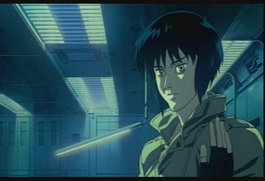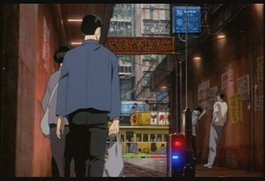Review
by Jonathan Mays,Ghost in the Shell
DVD
| Review: | ||||||||
If the purpose of a review is to determine whether a film is worth viewing, there is little to say about Ghost in the Shell. It exists on the elite plane of modern anime masterpieces, and for this reason alone, it should be watched. If the purpose of a review, however, is to examine a film's elements, ascertain its entertainment value, and consider its place within the evolving world of animation, there is much to discuss about Ghost in the Shell, and the conclusions are not so resolute.
In the year 2029, an expansive computer network unites the world. In Japan, a covert police division investigates cybercrime in this futuristic world of city-states and mega-corporations. Major Motoko Kusanagi, a member of Section Nine, searches for a deposed foreign despot seeking political asylum, leading to a person known as the Puppet Master, a hacker who is capable of penetrating even the strongest of the world's Internet firewalls. But as Motoko and her partner, Bateau, approach the hacker, the paramilitary security division of the Foreign Service interferes, executing a secret agenda. Meanwhile, Motoko must consider why the Puppet Master seeks her out specifically for his plans. As the title suggests, much of the film is consumed by the relationship between shell—body, human or cyborg—and ghost—self-awareness, identity through knowledge, soul. In essence, it is the question of the nature of self.  Breathtakingly beautiful art and animation accompany the introspective plot. The artwork is stunningly realistic, enhanced by the seamlessly integrated computer effects, perhaps the best synthesis ever witnessed in anime. Character designs are vastly different from those of manga artist Masamune Shirow, but they function effectively in the realistic art style. Scenes with little motion excel in nuance, while the select few action scenes are violent yet elegantly animated. Breathtakingly beautiful art and animation accompany the introspective plot. The artwork is stunningly realistic, enhanced by the seamlessly integrated computer effects, perhaps the best synthesis ever witnessed in anime. Character designs are vastly different from those of manga artist Masamune Shirow, but they function effectively in the realistic art style. Scenes with little motion excel in nuance, while the select few action scenes are violent yet elegantly animated.Voice acting is subtle but effective; Atsuko Tanaka's Motoko and Akio Ohtsuka's Bateau were particularly outstanding. Unfortunately, Mimi Woods' Motoko occasionally crosses the line from low-key to wooden, but the English dub is otherwise strong. Kenji Kawai's music contributes wonderfully to the atmosphere of the film, occasionally moving into the foreground as well. A rich blend of orchestral and choral timbres, the vast majority of his composition is understated and calming, making the occasional dissonance even more striking. His expressed doubt of the music's worthiness is to be ignored; the score is fantastic. The concept of detail is not foreign to science-fiction animation, but often it exists in the form of excessive technobabble and meticulously constructed—but ultimately insignificant—settings. This common fault is noticeably absent in Ghost of the Shell, a film that complements its attention to detail with exceptional cohesiveness of thought and plot. Perhaps the beautiful unity of Ghost in the Shell is best conveyed through example. At the film's midpoint, haunting music accompanies Motoko as she traverses the city. But an innocent interlude quickly evolves into thematic commentary as Oshii presents the viewer with a series of images; each passively provokes thought and gives the film's abstract concepts a more concrete foundation. Mokoto first notices several women casually moving through the city who share her facial composition, inviting the viewer to contemplate other similarities. The human tendency to link body and personality is strongly disrupted by this walk; among millions, Motoko sees time after time faces like her own. These confounding images are followed by scenes of warehouses, store windows, mannequins without faces—bodies without personality. In a mellow scene with no dialogue, director Oshii forcefully presents the dilemma of ghost and shell to the viewer. Once limited to Motoko's internal conflict, this theme, this independence of spirit and body, expands to infuse itself in every element of this spectacular film. Manga Entertainment's release of Ghost in the Shell is technically superior. The anamorphic video transfer is pristine, both the English 5.1 and Japanese 2.0 audio tracks are perfectly mixed and appropriately dynamic, and the multitude of extras is overwhelming. A twenty-six minute “Making of” provides many insights into the film's components, especially digital elements. Also of note is the exhaustive Guide to Ghost in the Shell—over 35 pages!—covering topics from net surfing criminals to the essence of the soul. It's a must-read for those who crave background information.  Despite the film's impressive scope and flawless presentation, those expecting an animated form of Masamune Shirow's Ghost in the Shell manga will be disappointed. Shirow's involvement with the film was limited, and it shows: both plot and characterization differ greatly from the manga. Also absent is Shirow's scattered humor, an element certain to be missed by many, though its inclusion may have disrupted the somber mood of the anime. Among the other potential drawbacks are long periods without excitement, but others will consider this a strength of the film. Action sequences are rare, and they are not frivolously sprinkled into the plot. Instead, they are precisely interpolated, a careful placement that enhances both the flash of action and the unsettling stillness that surrounds it. Despite the film's impressive scope and flawless presentation, those expecting an animated form of Masamune Shirow's Ghost in the Shell manga will be disappointed. Shirow's involvement with the film was limited, and it shows: both plot and characterization differ greatly from the manga. Also absent is Shirow's scattered humor, an element certain to be missed by many, though its inclusion may have disrupted the somber mood of the anime. Among the other potential drawbacks are long periods without excitement, but others will consider this a strength of the film. Action sequences are rare, and they are not frivolously sprinkled into the plot. Instead, they are precisely interpolated, a careful placement that enhances both the flash of action and the unsettling stillness that surrounds it.Nearly eight years after its release, Ghost in the Shell's caliber is evident, but its relevance is more difficult to declare. Some equate the film to Akira, but such hasty judgment fails to assess the qualities of each. Akira's analysis of power shares little with this film's rhetorical questions of humanity. Ghost in the Shell's themes, while superbly presented, have also been considered before in anime, so the lasting strength lies more in presentation than originality. Both films, however, may be credited with revolutionizing the world's reception to animation through Akira's 1989 theatrical run and Ghost in the Shell's simultaneous worldwide release. Thus, one may state with confidence that Ghost in the Shell is not only of high quality, but it marks a significant milestone in Japanese animation as well. As one who usually prefers anime that moves at a deliberate pace, I found Ghost in the Shell particularly enjoyable. Director Mamoru Oshii presents many fascinating concepts to consider, and the focused direction of the plot prevents the Easter egg hunt that plagues so many “intellectual” anime. Those in need of the occasional laugh will find it a more tedious viewing than most films, but to dismiss Ghost in the Shell is to deprive oneself of one of anime's truly magnificent experiences. |
||||||||
|
The views and opinions expressed in this article are solely those of the author(s) and do not necessarily represent the views of Anime News Network, its employees, owners, or sponsors.
|
| Grade: | |||
|
Overall (dub) : B+
Overall (sub) : A
Story : A+
Animation : A+
Art : A
Music : A
+ Film deserving of its impressive hype |
|||
| Production Info: | ||
|
Full encyclopedia details about Release information about |
||
